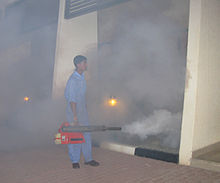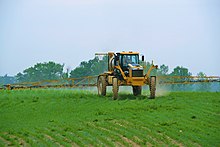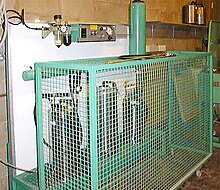
Pesticides are substances that are used to control pests. They include herbicides, insecticides, nematicides, fungicides, and many others. The most common of these are herbicides, which account for approximately 50% of all pesticide use globally. Most pesticides are used as plant protection products, which in general protect plants from weeds, fungi, or insects. In general, a pesticide is a chemical or biological agent that deters, incapacitates, kills, or otherwise discourages pests. Target pests can include insects, plant pathogens, weeds, molluscs, birds, mammals, fish, nematodes (roundworms), and microbes that destroy property, cause nuisance, or spread disease, or are disease vectors. Along with these benefits, pesticides also have drawbacks, such as potential toxicity to humans and other species.

Herbicides, also commonly known as weed killers, are substances used to control undesired plants, also known as weeds. Selective herbicides control specific weed species while leaving the desired crop relatively unharmed, while non-selective herbicides kill plants indiscriminately. Due to herbicide resistance – a major concern in agriculture – a number of products combine herbicides with different means of action. Integrated pest management may use herbicides alongside other pest control methods.

Insecticides are pesticides used to kill insects. They include ovicides and larvicides used against insect eggs and larvae, respectively. Insecticides are used in agriculture, medicine, industry and by consumers. Insecticides are claimed to be a major factor behind the increase in the 20th-century's agricultural productivity. Nearly all insecticides have the potential to significantly alter ecosystems; many are toxic to humans and/or animals; some become concentrated as they spread along the food chain.

Pesticide resistance describes the decreased susceptibility of a pest population to a pesticide that was previously effective at controlling the pest. Pest species evolve pesticide resistance via natural selection: the most resistant specimens survive and pass on their acquired heritable changes traits to their offspring. If a pest has resistance then that will reduce the pesticide's efficacy – efficacy and resistance are inversely related.

Integrated pest management (IPM), also known as integrated pest control (IPC) is a broad-based approach that integrates both chemical and non-chemical practices for economic control of pests. IPM aims to suppress pest populations below the economic injury level (EIL). The UN's Food and Agriculture Organization defines IPM as "the careful consideration of all available pest control techniques and subsequent integration of appropriate measures that discourage the development of pest populations and keep pesticides and other interventions to levels that are economically justified and reduce or minimize risks to human health and the environment. IPM emphasizes the growth of a healthy crop with the least possible disruption to agro-ecosystems and encourages natural pest control mechanisms." Entomologists and ecologists have urged the adoption of IPM pest control since the 1970s. IPM allows for safer pest control.

Pest control is the regulation or management of a species defined as a pest; such as any animal, plant or fungus that impacts adversely on human activities or environment. The human response depends on the importance of the damage done and will range from tolerance, through deterrence and management, to attempts to completely eradicate the pest. Pest control measures may be performed as part of an integrated pest management strategy.

Organic horticulture is the science and art of growing fruits, vegetables, flowers, or ornamental plants by following the essential principles of organic agriculture in soil building and conservation, pest management, and heirloom variety preservation.
A biopesticide is a biological substance or organism that damages, kills, or repels organisms seen as pests. Biological pest management intervention involves predatory, parasitic, or chemical relationships.
Non-pesticidal Management (NPM) describes various pest-control techniques which do not rely on pesticides. It is used in organic production of foodstuff, as well as in other situations in which the introduction of toxins is undesirable. Instead of the use of synthetic toxins, pest control is achieved by biological means.

A sprayer is a device used to spray a liquid, where sprayers are commonly used for projection of water, weed killers, crop performance materials, pest maintenance chemicals, as well as manufacturing and production line ingredients. In agriculture, a sprayer is a piece of equipment that is used to apply herbicides, pesticides, and fertilizers on agricultural crops. Sprayers range in size from man-portable units to trailed sprayers that are connected to a tractor, to self-propelled units similar to tractors with boom mounts of 4–30 feet (1.2–9.1 m) up to 60–151 feet (18–46 m) in length depending on engineering design for tractor and land size.

A spray nozzle or atomizer is a device that facilitates the dispersion of a liquid by the formation of a spray. The production of a spray requires the fragmentation of liquid structures, such as liquid sheets or ligaments, into droplets, often by using kinetic energy to overcome the cost of creating additional surface area. A wide variety of spray nozzles exist, that make use of one or multiple liquid breakup mechanisms, which can be divided into three categories: liquid sheet breakup, jets and capillary waves. Spray nozzles are of great importance for many applications, where the spray nozzle is designed to have the right spray characteristics.
Agricultural spray adjuvants are part of integrated pest management, and during pesticide application are used to enhance the effectiveness of pesticides, herbicides, insecticides, fungicides and other agents that control or eliminate unwanted pests. As with medical adjuvants, agricultural spray adjuvants are not themselves active in controlling or killing pests. Instead, these additives modify some property of the spray solution, which improves the ability of the pesticide to penetrate, target or protect the target organism. Among the typical types of ingredients used are surfactants, emulsifiers, oils and salts. Each of these ingredients, and others, modifies the spray solution itself to improve such properties as spreading, penetration, droplet size or other characteristics.

Pesticide drift refers to the unintentional diffusion of pesticides toward nontarget species. It is one of the most negative effects of pesticide application. Drift can damage human health. Together with runoff and leaching, drift is a mechanism for agricultural pollution. Some drift results from contamination of sprayer tanks.

Ultra-low volume (ULV) application of pesticides has been defined as spraying at a Volume Application Rate (VAR) of less than 5 L/ha for field crops or less than 50 L/ha for tree/bush crops. VARs of 0.25 – 2 L/ha are typical for aerial ULV application to forest or migratory pests. In order to maintain efficacy at such low rates, droplet size must be rigorously controlled in order to minimise waste: this is Controlled Droplet Application (CDA). Although often designed for non-evaporative formulations, ULV equipment may sometimes be adapted for use with water, often at Very Low volume VAR.

The environmental effects of pesticides describe the broad series of consequences of using pesticides. The unintended consequences of pesticides is one of the main drivers of the negative impact of modern industrial agriculture on the environment. Pesticides, because they are toxic chemicals meant to kill pest species, can affect non-target species, such as plants, animals and humans. Over 98% of sprayed insecticides and 95% of herbicides reach a destination other than their target species, because they are sprayed or spread across entire agricultural fields. Other agrochemicals, such as fertilizers, can also have negative effects on the environment.

Etofenprox is a pyrethroid derivative which is used as an insecticide. Mitsui Chemicals Agro Inc. is the main manufacturer of the chemical. It is also used as an ingredient in flea medication for cats and dogs.
To protect the continued use of biopesticides, the United States Environmental Protection Agency is requiring companies developing transgenic crops to submit and implement pest resistance management plans as a requirement of product registration.

A spray is a dynamic collection of drops dispersed in a gas. The process of forming a spray is known as atomization. A spray nozzle is the device used to generate a spray. The two main uses of sprays are to distribute material over a cross-section and to generate liquid surface area. There are thousands of applications in which sprays allow material to be used most efficiently. The spray characteristics required must be understood in order to select the most appropriate technology, optimal device and size.
The International Pesticide Application Research Consortium (IPARC), previously the International Pesticide Application Research Centre and before that the Overseas Spray Machinery Centre (OSMC), has focused on pesticide application methods appropriate for smallholder farmers since 1955. It is now a research and training group whose purpose is to promote practical and cost-effective techniques, wherever possible reducing the use of chemical pesticides, as part of Integrated Pest Management (IPM). IPARC has been an integral part of pesticide research and teaching at Silwood Park and has specialised in the needs of small-holder farmers, application techniques for migrant pests and control of disease vectors. IPARC is a World Health Organization (WHO) collaborating centre.

Weed science is a scientific discipline concerned with plants that may be considered weeds, their effects on human activities, and their management "a branch of applied ecology that attempts to modify the environment against natural evolutionary trends.".






















